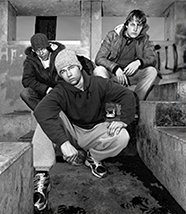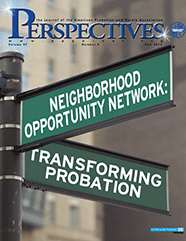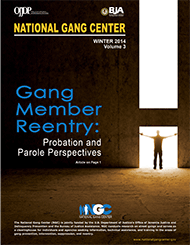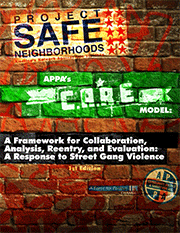
Youth Recommendations to Family, School, Community, and Law Enforcement Systems
A study funded by the South Coast Task Force on Youth Gangs surveyed 58 system-involved, male youth about how community members, families, teachers, and law enforcement could assist when youth leave a gang. Their responses included recommendations to promote educational and other goals, provide extracurricular activities, and support family counseling.

The Gang Intelligence Information Sharing project, currently managed by the IJIS Institute for the Bureau of Justice Assistance, takes a standards-based approach to gang intelligence information sharing, helping to combat the proliferation of gangs and to support the gathering of criminal intelligence about gangs.

In the Fall issue of 2013 the American Probation and Parole
Association released its first PSN update, a new column in APPA’s
quarterly journal Perspectives. As they are released, new
PSN updates can be found under the Resources tab of this website.

See highlights of the APPA membership interviews concerning gang member reentry needs in the Winter 2014 issue of the National Gang Center’s Newsletter.

As described by David Kennedy in this article from the Los Angeles Times, instead of doomed legislation aimed at increased background checks for firearm purchases “…the most powerful interventions aimed at day-to-day gun violence lie elsewhere. In the absence of any movement in the larger gun debate, mayors, police chiefs, prosecutors and academics have been moving on their own — and have made real progress. The way forward lies in two directions…” Specifically, interventions with high risk individuals and places.

Ashley Luthern of the Journal Sentinel reports on the Milwaukee Collaborative Offender Re-entry Program designed to keep juvenile offenders from re-offending. A pilot program aimed at juvenile offenders, in this partnership Milwaukee police officers and agents from the Wisconsin Department of Corrections conduct joint random home visits.

To assist community corrections agencies in the process of interagency collaboration, problem analysis, probationer/parolee reentry, and evaluation, the APPA developed the C.A.R.E. framework, a guide for responding to street gang violence. This comprehensive strategy combines lessons learned from previous anti-gang initiatives while providing an overview of four key components of anti-gang projects.
A national program is working to make neighborhoods safer everywhere and since being introduced in Yellowstone County earlier this year and it seems to be working. Project Safe Neighborhoods looks at areas of Montana with high crime rates. Now six months in, law enforcement believes that crime rates are decreasing.
It has been one year since the revitalized Project Safe Neighborhoods initiative launched in southeast Wisconsin. The program is designed to reduce crime and restore safety to communities. Within this initiative, there's a heavy focus on Milwaukee.
Keeping the streets of Indianapolis safe is the goal behind a federal program getting a renewed life in 2019. On Wednesday, United States Attorney Josh Minkler announced the launch of Project Safe Neighborhoods 2.0. Prosecutors say the Safe Neighborhoods Program introduced earlier this year has yielded strong results so far.
Attorney General Sessions Announces several Department of Justice actions to reduce the rising tide of violent crime in America. Foremost of those actions is the reinvigoration of Project Safe Neighborhoods, a program that has been historically successful in bringing together all levels of law enforcement to reduce violent crime and make our neighborhoods safer for everyone.


Copyright © 2012 - American Probation and Parole
Association
Contact us
Disclaimer: This web site is funded through a grant from the Bureau of Justice Assistance, Office of Justice Programs, U.S. Department of Justice. Neither the U.S. Department of Justice nor any of its components operate, control, are responsible for, or necessarily endorse, this web site (including, without limitation, its content, technical infrastructure, and policies, and any services or tools provided).